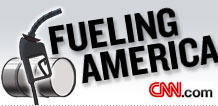|
BP plays defense Exec says company acted correctly after 2004 memo detailed corrosion; magnitude of pipeline closure expected to be revealed this weekend. NEW YORK (CNNMoney.com) -- A BP executive, under fire over the Alaska pipeline closure, defended the company's response to a two-year-old memo sent to BP's board detailing widespread corrosion, safety issues and other problems at the company's Prudhoe Bay oil field. The memo was sent in May of 2004 by Chuck Hamel, a onetime operator of tankers in the region and an advocate for BP employees in Alaska.
In the memo, Hamel said workers had expressed concern over worker safety, health and threats to the environment in Prudhoe Bay. "Some resigned because they didn't want to become part of the malfeasance of the corrosion program," Hamel told CNNMoney.com. But Hamel said BP seemed more concerned with finding out with whom he was speaking rather than fixing the problem. He said the company wanted names of workers who had talked to him and refused to work through an independent third-party mediator to address the issue, as he suggested. Hamel said in the end he never gave up the names, and nothing came of the matter. "I'm aware of the letter," Bob Malone, chief executive and president of BP America, said during an interview with CNN Wednesday. "BP brought that to closure based on the information they were given." "BP encourages our employees or the public to raise concerns," said Malone. "We have no interest in who is raising that concern, only in giving us sufficient information in addressing those concerns." Malone also defended the company against criticism that it neglected routine maintenance despite compiling record profits. "We spend $200 million a year on on in-field lines as well as on our transit lines, which is where we had the problem," he said. BP (Charts) posted a net profit of $22 billion in 2005. BP said Monday it was shutting down its Prudhoe Bay oil field after tests showed pipelines carrying oil from storage tanks in the field to the larger Trans-Alaska pipeline having walls corroded through as much as 70 percent of their thickness. Surprising and concerning? At the time of the announcement, a BP spokesman told CNNMoney.com the results of the tests were "surprising and disturbing." If the whole 400,000-barrel production that comes out of the field is shut down, as was originally announced, that would represent about 8 percent of total U.S. domestic output. But BP said Tuesday it is working with regulators to possibly keep the western half of the field open while the pipelines are replaced in the eastern half. Malone said Wednesday oil is still flowing from the western half while the eastern side is shut. He said the company currently has more than 100 workers inspecting the western half and that a decision on whether it can remain open is expected sometime between Friday and Sunday. Malone said the company now suspects bacteria may have played a part in causing the extensive corrosion. Government regulators suspected sludge buildup was a possible cause of the corrosion and said BP hadn't cleaned some of the lines since 1992, according to a June 5 letter from the Department of Transportation, which regulates pipelines. The agency said the 800-mile-long Trans-Alaska pipeline, which carries oil from the North Slope to its terminus at the sea in Valdez, is cleaned every two weeks. DOT noted that BP hadn't cleaned the lines, which is done using a device called a scraper pig, after a previous attempt to clean them was abandoned when the pig encountered too much sediment and almost became stuck. But the letter went on to say that DOT had "not received a reasonable explanation why BP has not scraper-pigged these lines over an approximate 14-year period," and that "this length of time does not represent sound management practices for internal corrosion control." BP couldn't immediately be reached for comment regarding the "scraper pig" issue. |
|


